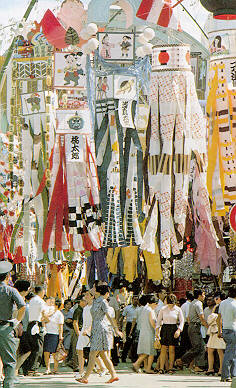
Japan in July
July 7: Tanabata

This is also called the Star Festival. It goes back to a legend that two stars, Altair (the cowherd star) and Vega (the weaver star) are lovers and allowed to meet only once a year.
Children and adults write wishes on narrow strips of colored paper and hang them on bamboo branches in their backyards or at the entrance to their homes.
This is another festival imported from China, during Japan's feudal period, but modified by the Japanese.
It is also another time when stores compete with each other which put up large decorations and compete with each other to see which store can have the most attractive display.

c. July 17th: Gion Festival
This festival has one of the oldest origins of all Japanese festivals, dating back to 896 when people gave thanksgiving for being spared from a plague. The people at that time put up 66 tall spears to represent the then-66 provinces of Japan and prayed to the god of good health to stop the plague.
The Gion festival is also one of the largest in the country. Huge floats are featured in parades, decorated with Persian carpets and very old tapestries. The festival activities can also go on for about a month.
July 20: Marine Day
This is the newest holiday in Japan starting in 1996. Technically it actually started in June of 1941 when it was called Marine Commemoration Day to honor the return of Emperor Meiji to Yokohama in 1876 from a trip he took to northern Japan. It wasn't actually a national holiday, though, an various organizations wanted something new to relate to the sea.
So the modified Marine Day was founded after several years of debate in the Diet.
July 28: Onda Matsuri
Aso-jinja Shrine, Ichinomiyacho, Kumamoto festival. This is held after the rice planting is done and features a parade of women carrying a midday meal to the gods and dressed in white robes.
Misc. items
1. Final exams
This is the time for the next round of final exams which are harder than the mid-term ones. Again all extracurricular activities are stopped for a week before the exams and no regular classes are even held. Elementary-school students are spared this, though; exams don't start until the seventh grade.
Final exams cover the five mid-term exam subjects of English, math, Japanese, science and social studies, but also add four more subjects-health and physical fitness, home economics, music and art.
2. Start of summer vacation
After final exams end students can start their summer vacation.
|